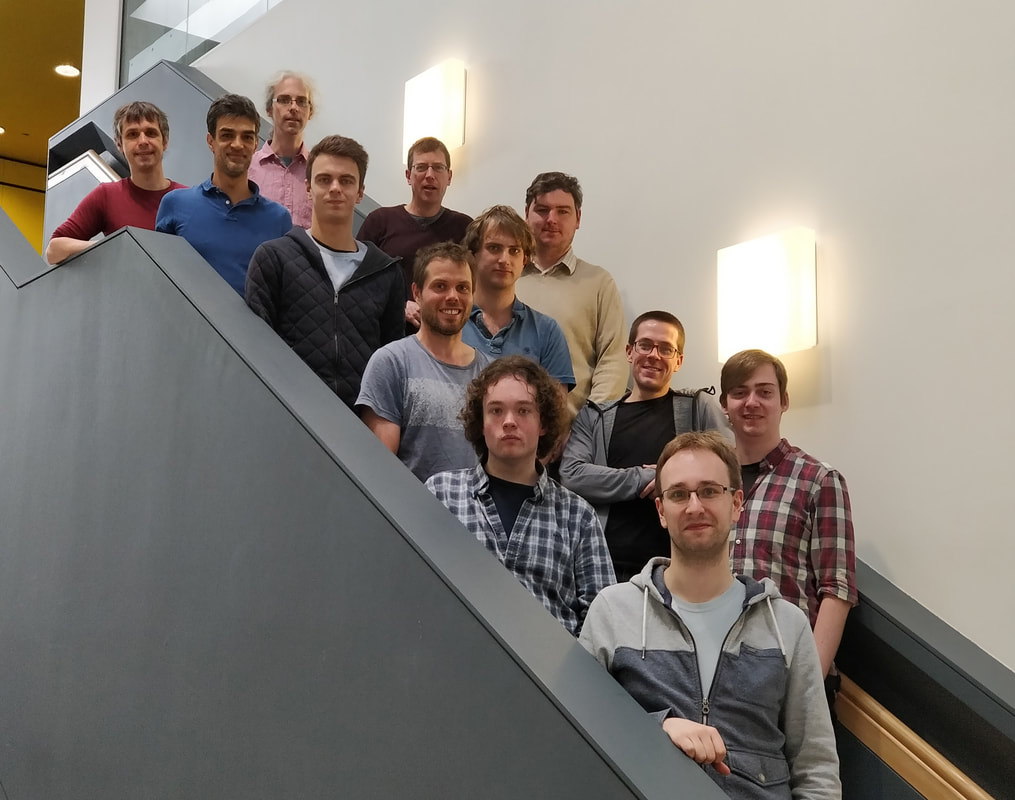
Condensed Matter Theory Group Meetings: Michaelmas 19/20
This term’s meetings will take place at 1pm on Mondays. This term will likely consist of talks, while at the same we can decide on a dice seminar topic to hit the ground running in Lent term.
Dice Seminars:
Sometimes we run Dice Seminars, which occur over the course of 5 weeks or so, and consist of us collaboratively learning about a given topic, by reading a paper or paper section, and rolling a dice to determine who will talk about what they’ve read. The previous topic was “Machine Learning”. The topic before that was “Topological Insulators”.
Other Meetings:
There are ~weekly condensed matter seminars at 3pm on Fridays, which will be interesting for anyone attending our group meetings. These are advertised internally.
Mailing List:
If you would like to be added to the mailing list for these meetings, please subscribe.
| Week | Presenter | Talk | Venue |
| 1 7th October |
Ed McCann | Pseudospin magnetism in graphene multilayers | A7 |
| 2 14th October |
Yunwei Zhang | Identifying degradation patterns of Li-ion batteries using machine learning method Abstract |
A7 |
| 3 21st October |
Lewis Williamson | Optical response of a chain of trapped atoms beyond the limit of low light intensity | C36 |
| 4 28th October |
Chris Parmee | Phases of driven two-level systems with nonlocal dissipation Abstract |
A7 |
| 5 4th November |
No Seminar | A7 | |
| 6 11th November |
Edward Laird | A coherent mechanical oscillator driven by single-electron tunnelling through a suspended carbon nanotube Abstract |
A7 |
| 7 18th November |
No Seminar | A7 | |
| 8 25th November |
Marcin Szyniszewski | Random-matrix perspective on many-body entanglement with a finite localization length | A7 |
| 9 2nd December |
Alessandro Romito | TBC | A7 |
| 10 9th December |
Hamed Ghaemidizicheh | TBC | A7 |
Abstracts
Yunwei Zhang – Identifying degradation patterns of Li-ion batteries using machine learning method
Forecasting the state of health and remaining useful life of Li-ion batteries is yet an unsolved challenge that limits technologies such as consumer electronics and electric vehicles. We build an accurate battery forecasting system by combining electrochemical impedance spectroscopy – a real-time, non-invasive and information-rich measurement that is hitherto underused in battery diagnosis – with Gaussian process machine learning. We collected over 10,000 EIS spectra of commercial Li-ion batteries at different states of health (SoH), states of charge (SoC) and temperatures – the largest dataset to our knowledge of its kind. Our Gaussian process model takes the entire spectrum as input, without manual feature engineering, and automatically determines which spectral features predict degradation. Our model significantly outperforms the state of the art, accurately predicting remaining useful life (RUL) even when the past operating conditions of the battery are unknown to the user. The model can be interpreted to shed light on the physical mechanisms of battery degradation. Our results are uniquely able to design the next-generation intelligent battery management systems which would enable a considerably safer operation of Li-ion batteries.
Chris Parmee – Phases of driven two-level systems with nonlocal dissipation
When closely packed together and driven by an external field, cold atoms exhibit strong dipole-dipole interactions, which give rise to energy level shifts and nonlocal dissipation. These effects significantly alter the response of the ensemble compared to a system of non-interacting scatterers. Here, we ask how dipole interactions influence the long-time steady states of a 1D atomic array when only two energy levels of an atom are driven. In this setup, the atoms behave as a many-body open quantum system of dipole coupled two-level spins. We investigate the long-time dynamics of the system at the mean-field level and use this to determine a phase diagram as a function of external drive and detuning. We find a multitude of phases including antiferromagnetism, spin density waves, oscillations and phase bistabilities. We investigate these phases in more detail, explaining how nonlocal dissipation plays a role in the longtime dynamics as well as discussing what features would survive in the full quantum description.
Edward Laird – A coherent mechanical oscillator driven by single-electron tunnelling through a suspended carbon nanotube
Suspended carbon nanotubes are mechanical resonators with low mass, high compliance, and high quality factor, which make them sensitive electromechanical detectors for tiny forces and masses. These same properties are favourable for studying the effects of strong measurement backaction. This talk will describe fast electrical measurements of a vibrating nanotube in which electron tunnelling excites spontaneous mechanical oscillations.
Our device consists of a clean carbon nanotube, spanned across a trench. A pair of tunnel barriers defines a single-electron transistor, whose conductance is proportional to the displacement. With low coupling, the single-electron transistor is a sensitive transducer of driven mechanical vibrations. At intermediate coupling, electrical backaction damps the vibrations. However, at strong coupling, the resonator can enter a regime where the damping becomes negative; it becomes a self-excited oscillator.
This electromechanical oscillator has many similarities to a laser, with the population inversion provided by the electrical bias and the resonator acting as a phonon cavity. We characterize the resulting coherence and demonstrate other laser characteristics, including injection locking and feedback narrowing of the emitted signal.